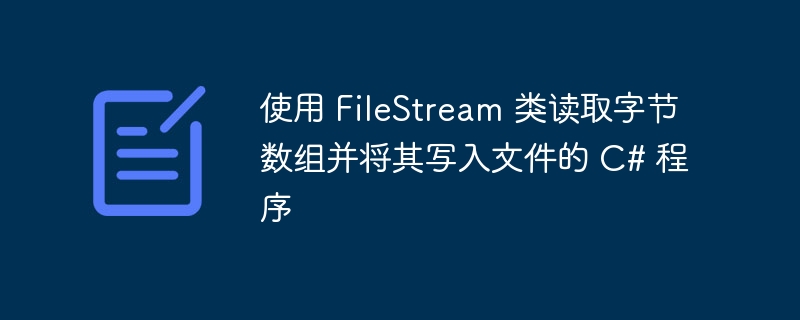

C# is a powerful object-oriented programming language used for developing various applications. In this article, we will discuss how to write a C# program to read and write a byte array to a file using the FileStream class.
The first step in the program is to create a byte array that we want to write to the file. Here is an example -
byte[] byteArray = { 0x48, 0x65, 0x6c, 0x6c, 0x6f, 0x20, 0x57, 0x6f, 0x72, 0x6c, 0x64 };
The next step is to use the FileStream class to write the byte array to the file. We need to create a new instance of the FileStream class and pass the file path, FileMode, FileAccess and FileShare as parameters to its constructor. Here is an example -
string filePath = "C:\MyFile.txt";
using (FileStream fileStream = new FileStream(filePath, FileMode.Create, FileAccess.Write, FileShare.None)) {
fileStream.Write(byteArray, 0, byteArray.Length);
}
To read a byte array from a file, we need to create a new instance of the FileStream class and pass the file path, FileMode, FileAccess, and FileShare as parameters to its constructor. We then create a byte array and read the contents of the file into the byte array using the Read() method of the FileStream class. Here is an example -
byte[] readByteArray = new byte[byteArray.Length];
using (FileStream fileStream = new FileStream(filePath, FileMode.Open, FileAccess.Read, FileShare.Read)) {
fileStream.Read(readByteArray, 0, readByteArray.Length);
}
Finally, we need to compare the original byte array and the byte array read from the file to make sure they are the same. We can compare two byte arrays using the SequenceEqual() method of the Enumerable class. Here is an example -
bool areEqual = byteArray.SequenceEqual(readByteArray);
This is the complete C# program -
using System;
using System.IO;
using System.Linq;
namespace ByteArrayToFile {
class Program {
static void Main(string[] args) {
byte[] byteArray = { 0x48, 0x65, 0x6c, 0x6c, 0x6f, 0x20, 0x57, 0x6f, 0x72, 0x6c, 0x64 };
string filePath = "C:\MyFile.txt";
// Write byte array to file
using (FileStream fileStream = new FileStream(filePath, FileMode.Create, FileAccess.Write, FileShare.None)) {
fileStream.Write(byteArray, 0, byteArray.Length);
}
// Read byte array from file
byte[] readByteArray = new byte[byteArray.Length];
using (FileStream fileStream = new FileStream(filePath, FileMode.Open, FileAccess.Read, FileShare.Read)) {
fileStream.Read(readByteArray, 0, readByteArray.Length);
}
// Compare the byte arrays
bool areEqual = byteArray.SequenceEqual(readByteArray);
Console.WriteLine("Are the byte arrays equal? " + areEqual);
}
}
}
Are the byte arrays equal? True
In this article, we learned how to write a C# program using the FileStream class to read and write byte arrays to files. This program can be used in a variety of scenarios, such as reading and writing image or audio files. By understanding the concepts covered in this article, you can develop more advanced applications that require file input and output. I hope this article has been helpful in your programming journey. Happy coding!
The above is the detailed content of C# program to read a byte array and write it to a file using the FileStream class. For more information, please follow other related articles on the PHP Chinese website!
 Scope permission opening method
Scope permission opening method
 What are non-relational databases?
What are non-relational databases?
 The difference between anchoring and aiming
The difference between anchoring and aiming
 What is the difference between full-width spaces and half-width spaces?
What is the difference between full-width spaces and half-width spaces?
 jdk environment variable configuration
jdk environment variable configuration
 SQL statement to backup database
SQL statement to backup database
 What to do if css cannot be loaded
What to do if css cannot be loaded
 What are the tips for using dezender?
What are the tips for using dezender?
 The eight most commonly used functions in excel
The eight most commonly used functions in excel




